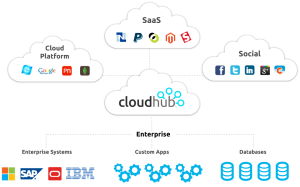
Atlassian is famous for being one of the first startups to sell B2B product without a sales team. How? This post gives a rundown of the product strategy used by Atlassian and newer Silicon Valley startups to enable a scalable ‘low touch’ sales model. I’ll focus on the tricky task of selling to software developers, but these techniques should be useful for a range of B2B industry spaces.
1. Wrap Your Product In A Hot Industry Trend
The easiest ways to get press are when your product first launches, when you hit a big milestone, or when something terrible happens. Everything else requires generating your own buzz through research, product updates and market insights. Hard research means that you can delve valuable information for you existing and potential customers. Example content can target specific industry segments and technology stacks, from “Building a mobile application backend”, a technical walkthrough like ‘Fixing bad data‘ from Dataomic, or an introduction to how your company handles development internally, such as Agile at Atlassian. Atlassian was initially successful at using JIRA to deliver agile development practices. Your goal should be to become synonymous with a growing practice such as hosted subscription managment or web optimization.
My experience is push content into permanent, polished website format in preference to your blog. Reserve your product blog for low-level product updates, internal thoughts, upcoming events. Successful blog content can always be recast into more permanent, polished website content. Similarly, many marketing teams build excellent case studies and white papers, but don’t invest this material out into their broader website messaging.
2. Enable Early Adopters To Sell Internally
Developer-focused tech startups often struggle with transitioning their sales process from developers over to management to complete their decision makers, or vice versa, so an essential component to successful marketing is to capture your intended handoff process between management and end users using information from real sales. If your strategy is to win over developers first, you can often help them to sell your product internally through self-service sales process. This requires a host of presales material including white papers, sales brochures and Powerpoint presentations, plus webinars and sharable product videos. Once you understand your sales cycle, enable developers to start a free trial with a minimum of fuss and continue getting hooked on your tools until the appropriate point to close the sale. Consider Why Docker.

3. Get Website Visitors Into Your Product ASAP
All the marketing content in the world is just a proxy for the actual product. I am a huge fan of homepages that let me jump straight into the actual application, whether it’s a one-click live sandbox or one-page trial signup. Consider Stripe and Optimizely‘s above-the-fold live signup. Packaged tools such as Mean.io include the code to install their service on their homepage. There are a few exceptions here for businesses which rely on professional services, enterprise sales teams or deep customization to close deals.
4. Offer Premade Environments & Quick Starts

How can you minimise the ‘time to value’ for your product? An extension of making your tool easy to try, is to offer customisable installations to your developer’s use cases and technology stacks. Github tutorial apps and templates offering a comprehensive range of sample applications and templates to suit your target market’s technology stacks. Example use cases could include ecommerce, mobile backend or social applications, while common technology stacks include frameworks like Bootstrap or languages Node.js, Ruby on Rails, Python, PHP and Java. Examples include Parse’s range of Github template repositories, Bitnami’s front-page launcher and the Heroku Helios mobile framework.
5. Publicise Your Design Principles
Publicly stating your product design principles is an easy way to showcase your market differentiation. Consider Chef’s principles for automation or Heroku’s Twelve Factor App manifesto, which set the tone for their application-centric PaaS design. The Ruby on Rails approach to opinionated software should set distinguishing principles which your competition either fails at, or doesn’t want to chase in the first place. On a related note, many developer tools take a more fun approach to their own branding and design, such as Mailchimp or the Loggly beaver.

6. Showcase Your Integration Ecosystem
Most developers use a specific suite of infrastructure tools that they consider best-of-breed. For example, New Relic for application performance management, plus Docker on AWS or Heroku for hosting platform, Pagerduty alerts etc. An easy way to show market maturity is to showcase how your tool integrates with the rest of your target market stack.
7. Guide User Flow Between Your Website, Tutorials & Documentation
Technical products should expect that potential customers will want to review your documentation and example applications as part of their evaluation. Respond to this by designing a clean, two-way visitor flow between your homepage introductory content and more technical documentation so that users can flow into tutorials and example applications. Polished and personality-filled documentation sets a high standard for your actual product. Many development tools should plan to launch product trials through their pricing page or technical tutorials.
8. Segment Your User Onboarding By Use Case
Many companies don’t invest in industry-specific onboarding beyond custom landing pages and perhaps case studies, but once you have substantial traffic then it’s often worthwhile to plan out specific paths for each customer persona. This makes it easy to tailor your content and social proof to maximize conversions. Urban Airship is a good example of industry-specific onboarding.
Similarly with case studies, many companies throw out their biggest customer names to maximize their ‘wow factor’, but customers are often more impressed by seeing similar and complementary companies than Fortune 500 companies. Consider segmenting your use cases within specific industry verticals, such as ecommerce, travel or IT services.
9. Contextual Messaging Outperforms Email

Many developers are indifferent to email at best. While email is appropriate for users who abandon your product after initial signup, and it’s easy to offer an email newsletter, this preference should drive your attention toward web content, blogging and in-app messaging for trial users.
My experience with in-app contextual messaging is that it is essential to improving onboarding success, since your marketing team can selectively communicate with users without having to rely solely on email. An inhouse messaging platform or a whitelabel solution such as Intercom enables both automated marketing based on user behavior, and manual campaigns such as relevant upcoming webinars. An information bar, carefully-used popup, or new user wizard has the added bonus of enabling your operations team to communicate potential service issues such as planned outages.
10. Ship Presales Material In-Product
Your onboarding material should be built right into your product. Consider how you can monitor your user’s in-app behavior to flag them into specific campaigns, for example to identify a mobile developer and invite them to an upcoming, mobile-specific webinar. A hugely successful example was Atlassian’s Confluence wiki, which ships with a demonstration that showcases a finished wiki space, introduces core concepts and provides templates for actual teams such as sales and marketing.


